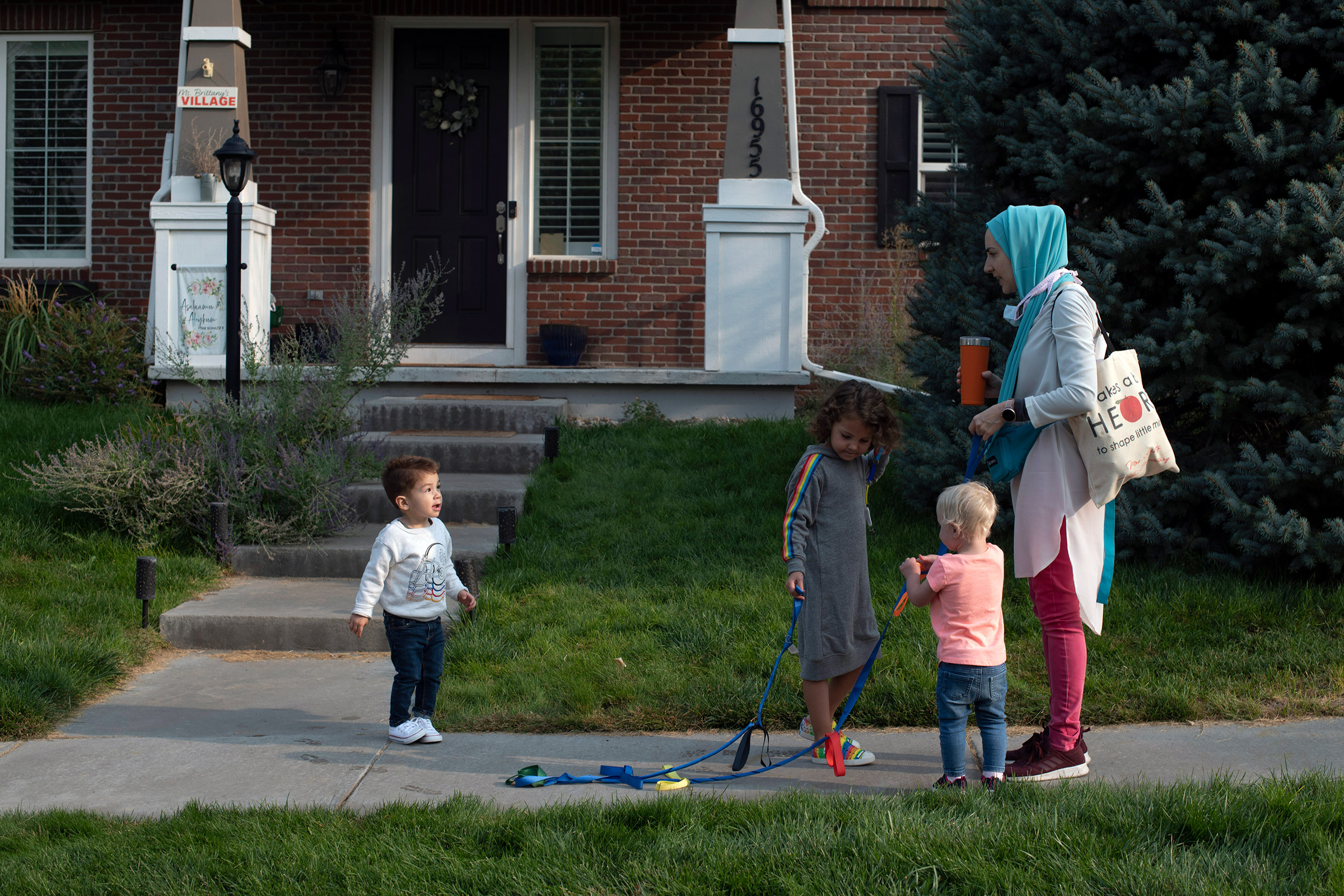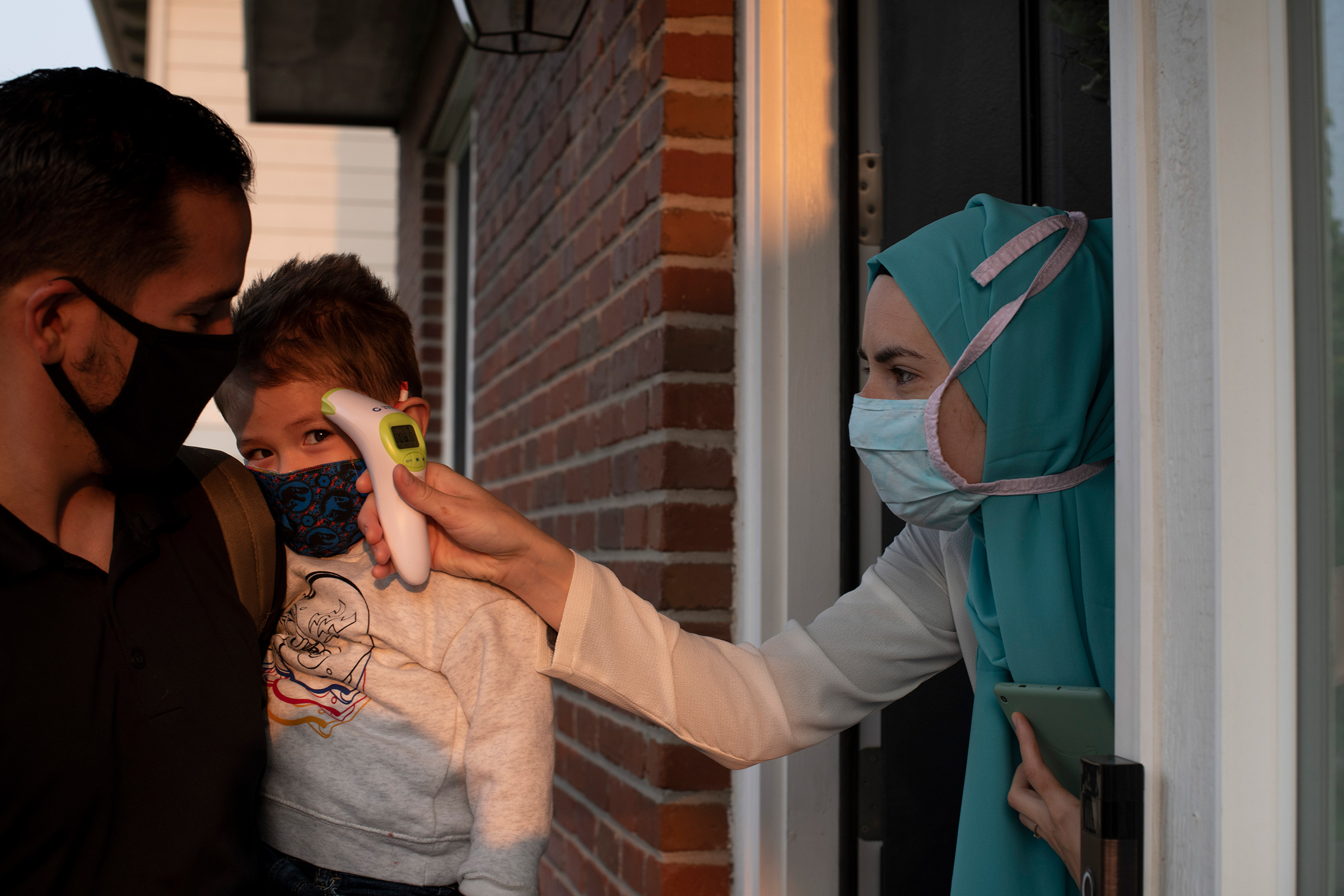
For the past six years, Brittany Schultz has been a kindergarten teacher in the Denver public school system. On May 28, she left, and on June 15, she opened Ms. Brittany’s Village day care in her home in Commerce City, Colo., with her three children and one from another family. Within two months of opening, she was, she says, making the same money as she had made in a classroom but was responsible for only nine kids. She and her husband, who works with her, currently earn about $5,000 a month.
Schultz is a peppy, can-do woman with the indefatigable good cheer and focus that are key to working with little kids. But even for the very energetic, to go from zero to opening a childcare center in a matter of weeks is remarkable. The licensing procedures and safety requirements are significant, and can require home renovations. Opening your own business in the teeth of a pandemic shutdown takes some guts. And many teachers, especially those with graduate degrees like Schultz, have historically shunned a change of profession to what many see as babysitting. Home-based centers are often regarded as the used-car yards of the U.S. childcare ecosystem: the place people go when they can’t afford anywhere else, which may be why the number of fully licensed operations has more than halved in the past 15 years, from almost 200,000 to 86,000.
One of the reasons Schultz was able to move so swiftly was that she had joined a childcare franchise known as MyVillage, a Colorado startup that matches parents with caregivers, eHarmony-style, and takes care of a lot of the administrative work, like billing and insurance. MyVillage is one of a growing number of companies—usually with reassuring names like Wonderschool, WeeCare or NeighborSchools—that are trying to use technology to transform the day-care industry by creating more home-based care centers, and improving the reputation and profitability of the ones that already exist. Childcare veterans warn that they have a steep climb ahead of them.

About 7 million children under the age of 5 are cared for in someone’s home, according to the 2016 National Survey of Early Care and Education. About 4 million of them are looked after by a relative. The other 3 million are in a home day care. Despite the number of children they care for, however, these home-based day-care centers have often been overlooked-—by policymakers and legislators, parents and nonprofits—since more than 90% of them are not regulated, and it’s difficult to get a clear idea of the standard of care. Expanding and improving the sector was one of the centerpieces of the childcare-reform initiative that Ivanka Trump shepherded through the White House in December, though it stopped there.
But now a perfect storm has landed on the childcare landscape, whipped up by the twin fronts of fear and opportunity. Many parents, spooked by the potential for COVID-19 infection at big centers, and no longer necessarily commuting to work, are looking for smaller, more local options for their children, especially those that will take siblings of different ages. Millennials, raised in the sharing economy, already regard domestic space as multipurpose. Teachers like Schultz, alarmed by the prospects of either teaching entirely online, or contagion in schools, are looking for another way to work. People suddenly need jobs. And governments and employers have come to realize that without childcare, their workforce is significantly less productive. The expensive on-site office childcare centers sit empty while employees stagger under the double load of parenting and working from home. Everyone’s looking for new solutions.
These winds are buffeting a care system for the youngest Americans that was already in disarray, and childcare tech entrepreneurs believe they have the solution. For a fee, they offer home-based carers help with the tasks that algorithms do well, including payroll, marketing, billing and scheduling. They provide curricula, training webinars, mentorship and often a kind of virtual teachers’ lounge, where providers can mingle with others and kvetch or offer support, and a path to licensure. They have search portals to match parents and local providers. One of them, Wee-Care, suggests that providers could make $100,000 a year: 300% more than the industry average.
While the pandemic has been hard on all providers, home-based centers have proved the most robust. The Bipartisan Policy Center (BPC) found that childcare centers operating out of people’s homes were the most likely of any type of provider to stay open. More than a quarter of them continued operating without any interruption, while only 12% of childcare chains kept functioning.

The representatives of the tech-based networks talk about home-based childcare not as a last resort, but as an artisanal, locally sourced amenity, childcare’s version of Airbnb—that could also change the world. “The continuity of care and this partnership that develops between a provider who works with the child for a couple of years and a parent, that’s the magic of it,” enthuses Brian Swartz, one of the founders of the Boston-based NeighborSchools. “We think this is the model for the future of childcare in America.”
This has not been the way home day cares have been regarded by many parents. “I was worried initially because of all the bad stories from social media about in-home day care,” says Victoria Melanson, who needed care for her 3-year-old son after the pandemic meant older relatives could no longer look after him. Bigger chain centers were out of the family’s price range, if they were open, so she went with a home day care through NeighborSchools, and loves it.
These “carebnbs,” as they might be called, had been around before SARS-CoV-2 arrived, but the virus has made their business more relevant. WeeCare, the biggest of the networks, had 600 day-care providers signed up in December, almost all in California. As of October, it has 2,700 providers across 25 states. Wonderschool, which started in 2017 and got a $20 million injection of funds from investors led by Andreessen Horowitz a year later, now has 1,000 centers. Interest from parents has skyrocketed, especially for those centers that are outdoors, sometimes known as forest schools. Both NeighborSchools and MyVillage have expanded their geographic reach during the pandemic, and several platforms have started partnerships with businesses looking to help their employees.
Ask any parent about the U.S. childcare system, and you can settle in for a long and exasperated detailing of the parlous state of affairs. “In my city, there are not a lot of options that are affordable but high-quality,” says Mike Schmorrow, a lumberman from Gloucester, Mass. He didn’t qualify for any childcare subsidies, “even though if I were to pay the full retail price, I wouldn’t be able to afford to live.” He ended up sending his son to a home-based day care half an hour away, which charged him $100 for two days. On the other end of the income spectrum, Jessica Chang, who founded WeeCare, was so confounded by finding care that she bought and operated three preschools herself before building the online childcare marketplace. “Preschools don’t scale,” she says.


In many ways, childcare in a local person’s home is one of the most ancient and global infant-rearing practices we have. Mothers have been leaving their children with trusted and experienced neighbors since people first started to gather in villages. But perhaps because the work has always been done by women—and, in America, women of color—it does not attract the respect that might logically be accorded to people who nurture our newest beings.
According to Home Grown, a national organization that advocates for home-based care centers, sometimes called family childcare centers or in-home childcare, there are about 1.12 million paid carers who work in their homes, of whom only 7%—some 86,309—are fully licensed. These are the ones whose numbers have been dropping the fastest; more than a fifth of them have closed in the past six years. This decline, experts agree, is one of the prime drivers of the increasing number of what are called childcare deserts: areas where the demand for childcare vastly exceeds the supply.
It’s not quite clear why the home day-care sector has shrunk. Linda Smith of the BPC believes retiring providers are not being replaced. Chang says she found “a significant disconnect between millennials who are now the parents and the baby boomers who were all the providers. Many of them didn’t have websites … or even any reviews online.”
But nearly everyone suggests it’s simply because the work is hard and the rewards and respect are low. Most home-based day-care providers’ journey to profitability is not as smooth as Schultz’s. Joy Gilbert opened her first home-based childcare center in 2017, for her son and the children of friends and family. “I just set up my own space in my mom’s home,” she says. “I didn’t really know much about the billing process and stuff. I wouldn’t say it was the best financially.” When the childcare center she had been working at before she had her son found a space for him, she went back to work there.

“Even during regular times, it is not easy to be a home-based childcare provider,” says Natalie Renew, director of Home Grown. The hours are long—a Health and Human Services survey put it at an average of 56½ hours a week—and the pay is suboptimal, about $30,000 a year for a licensed provider, less for an unlicensed one like Gilbert. The business is also precarious. Most states allow only four infants or up to eight children if some are over the age of 6. Many take several kids from the same family. If just one family pulls out—because of job loss, a move or countless other life changes—the provider loses a huge chunk of her income. All the technology in the world can’t forestall this. MyVillage was able to raise some funds from its investors for their providers who lost clients in the pandemic, and Home Grown spread $1.2 million around 12 states, but it’s like pouring a cup of water on a forest fire.
Ani Gharibian, 34, shut down her North Hollywood Busy Bee Daycare for a few weeks during the pandemic, but reopened when her financial situation grew dire. She has 14 kids, from 11 months to first grade, including her son. “I can’t say that it provides me with a very comfortable life. I can pay for the house I’m in and food for the kids and my kids and that’s enough,” she says. Despite this, she’s pleased she signed up with WeeCare after a divorce forced the closure of her first home-based daycare. “Whatever I have to give them, it’s completely worth it. It’s not that much of a difference that I can feel it.” WeeCare’s platform enabled her to find families quickly and for them to pay via credit card, making transactions much simpler.
It’s clear that home-based care is a vital part of the childcare infrastructure, serving more vulnerable populations, younger children and low-income families. Homes are also the preferred care option of most families of color, says Myra Jones-Taylor, chief policy officer of early-childhood organization Zero to Three. “There’s a vast body of research that shows that Black boys are being treated as menacing and deserving of discipline at an early age,” she says. “We already see the racial bias emerging in preschool.” Parents feel their sons, especially, will be treated more fairly at home-based care centers. “They don’t have to worry about a cultural bias,” says Jones-Taylor. “The women are of the community.”
Community is part of what drew Gilbert to the profession. After she got furloughed from her day-care center at the start of the pandemic, she answered an ad for MyVillage: “It seemed like the perfect fit. I could look after my children and at the same time help other families.” -Visiting the organization’s chat room about twice a week has helped her feel less isolated—and understand the thicket of compliance and training regulations that she needs to meet to get licensed in Colorado. “If I didn’t have MyVillage, I probably would not have pursued licensing so soon. I feel like it’s kind of a lot to do by yourself,” she says. Gilbert watches two children, plus her own two kids, right now, but if she got her license and enrolled five, she says, she would triple the income from her last job.
While the stated aim of all the new home-care networks has always been to increase the supply of childcare, the situation is beginning to look a little like a land grab of existing providers. “Some of the other [startups] have all but stopped supporting new providers,” says Swartz of NeighborSchools, which is aiming for a 50-50 mix of newbies and existing centers. “My understanding is they found it to be laborious.” It makes sense that the tech industry wants to work mostly with providers who are already licensed, who can charge enough that the percentage is worthwhile, but it’s a little like retrofitting the lifeboats on the Titanic; the vast majority of home-based childcare providers do not fall into this category.

Nonprofits, foundations, state governments and local communities have been trying to remedy the low level of licensing for years. Jessica Sager started her nonprofit All Our Kin 20 years ago, and works intensively with home-based caregivers in Connecticut and New York to raise quality and put them on the path to licensure and thus more profitability. The tech approaches are helpful, she says, but the real work of training and helping home-care providers is “deep, deep in-person work.”
Other childcare advocates worry that tech companies will not build platforms capable of reaching the families who need the most help, those who are poor enough that their childcare is subsidized by the government. An investigation by the nonprofit education news service the Hechinger Report found that as of December 2018, only 12% of Wonderschool families paid with government vouchers, and 30% of WeeCare families. These days, reps from both networks say, at least 40% of their franchisees are working with families who have subsidized care.
But if nothing else, the tech people are bringing entrepreneur-level energy to an industry that has long had very little agency. After providers were prevented from opening centers by some Colorado homeowners’ associations, MyVillage spearheaded a law that disallowed such exclusions. When NeighborSchools had more than 100 women stuck in a Massachusetts licensing bottleneck, Swartz complained to the media and got a call from the early education commissioner that day.
Veterans of the battle for childcare are mostly welcoming of the new recruits with their shiny new tools, but are wary of seeing them as the solution. “I think they have a place in our system. Do I think they’re the saving grace?” says Linda Smith. “Nuh-uh.” After 40 years working on the issue, including a stint in the Obama Administration, she says the missing piece of the childcare puzzle is an understanding among policy-makers, business leaders and the non-parent public about how much it really costs to look after very young human beings. The childcare crisis will not be solved, she and other advocates believe, until that realization sinks in. But since that might be a while, advocates say, anyone is welcome to dig in and help.
More Must-Reads from TIME
- Cybersecurity Experts Are Sounding the Alarm on DOGE
- Meet the 2025 Women of the Year
- The Harsh Truth About Disability Inclusion
- Why Do More Young Adults Have Cancer?
- Colman Domingo Leads With Radical Love
- How to Get Better at Doing Things Alone
- Michelle Zauner Stares Down the Darkness
Contact us at letters@time.com